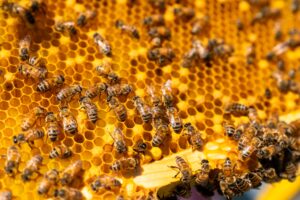The next time you open your pantry or fridge, pick five foods. Do you know where they came from?
Who grew that potato? Whose cow produced that milk? How many food miles did they collect on their way from farm to fork?
Consumers are asking more and more questions about where their food comes from and how it’s farmed. Many want to understand the impact agriculture has on the environment. They’re driving the demand for sustainable and socially responsible products.
As ‘eating eco’ grows in popularity, so does regenerative farming.
The tyranny of distance
WA is home to a 15.4 million hectare Wheatbelt so big you can see it from space.
But much of our WA produce travels overseas before it reaches our local supermarket.
The COVID-19 pandemic has disrupted the global food supply chain. It has affected production, processing, distribution and demand. It’s the reason shelves at your grocery store might be empty.
The flip side is we’re becoming more aware of the journey our food takes from paddock to plate.
What is regenerative farming?
Regenerative agriculture is a holistic approach to farming. The land management practice is low-impact and based on the principle of enhancing the natural ecosystem. It’s about leaving the land better than you found it.
It’s not a new idea. Pre-colonial Aboriginal societies used regenerative farming practices for thousands of years. Bruce Pascoe’s book Dark Emu famously posits that Australia’s great desert interior was once a vast farmland.
And with plenty of case studies of WA farmers embracing modern-day regenerative principles, it’s safe to say that there seems to be a resurgence occurring.

Tom and Emma Mitchell started using regenerative farming practices to combat parasites on their Worrolong property, 1.5 hours north of Perth .
The farm was infected with root-knot nematode, a worm that destroyed their pumpkin crop. They had to choose between applying pesticides each year or encouraging soil biodiversity. They went with the latter.
“We sow lupins and legumes for nitrogen. We will also sow oats after our pumpkins to capture any nutrients left in the soil and store carbon,” says Tom.
Most of the other crops are not sold for profit but make the soil healthy for their annual pumpkin harvest and citrus orchard.
A new (re)generation?
Dr Ben Cole runs Wide Open Agriculture, which connects farmers and sellers to produce more sustainable food.
“The farmers I speak with describe it as farming with nature rather than against it,” says Ben.
“It maximises what nature gives you for free rather relying than on external inputs,” he says.
“[Regenerative farmers] focus on soil health. They focus on building carbon and the soil web. It is feeding the soil, not the plant, then supporting above-ground biodiversity.”
The soil-first approach values the rhizosphere. This is the area of soil that surrounds a plant’s roots. It teems with microscopic organisms that interact with each other and the plant.
Farmers know that soils full of nutrients and healthy living things are vital for good crop yields. This means farmers need to cycle crops and care for the soil.
But farmers can only sell what we buy. And that’s rarely the best crop for the soil.
Waking up to nature
“The CSIRO found cattle and sheep can graze on some native plants that also have deep roots for the landscape. We’ve been amazed by just how well they grow,” says Ben. But this only works for livestock farms.

Millet and legumes revitalise soils after farmers harvest cash crops like sugarcane and wheat. But low demand means farmers plough these crops into the ground or instead use artificial fertilisers sourced internationally. They have large carbon footprints and poorer nutrition.
As consumers, we encourage good farming practices by understanding where our food comes from. But what about farmers looking to make a positive change? Tom’s advice is to take it one step at a time.
“Don’t expect to do everything at once. That transition phase can be lethal economically if you’re trying to switch everything over in one step. Do what is easy to do first, and slowly work your way to a more complete system.”











